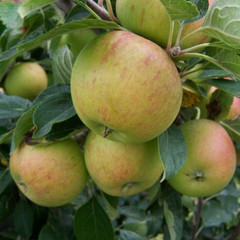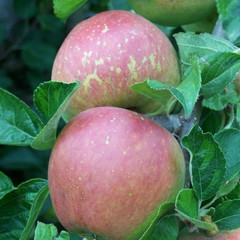Description
Discovered by a Mr Kempster of Woodstock, Oxford in the late 18th C close to Blenheim House. Originally named Kempster's Pippin in honour of the finder, it was subsequently renamed Blenheim Orange in honour of the Duke of Marlborough (Blenheim Palace), and advertised as such from about 1804. The large, round flat fruit are dull yellow, flushed red, with a slightly russeted skin, being crisp, sweet, juicy and with a distinctive almost nutty flavour. Makes a large, spreading flat headed tree that fruits better with age. Notable offspring include Bramley's Seedling, Cox's Orange Pippin, and Newton Wonder.
...the old Blenheim Orange, which over a hundred years ago set a new standard of quality and which remains yet in the first rank. Its attractions are not so obvious nor do they set out to woo a youthful love of sugar or spicy aromas, but there is a flavour which does not resemble the raspberry or strawberry, nor does it mimic the fennel, but remains the very attar of apple, unique and inimitable.
E. A. Bunyard, The Anatomy of Dessert, 1933
"Bunyard also said that the Blenheim qualities are shared by few, Orleans Reinette is its most notable analogue'. Though sometimes considered a 'southern' apple, the Blenheim has long been popular in the north, in home orchards and walled gardens, and according to Backhouses, who say it is a Select Dessert Cultivar, to be recommended for Market Culture, for no doubt it fetched a good price. No doubts either as to its hardiness, it has been grown commercially in France, Germany, eastern Europe and the former USSR, Scandinavia, (gathering synonyms on the way), the USA and Canada, and Australia, but no longer on any significant commercial scale in the UK.
Its reputation as an erratic bearer probably results from pollination issues; several northern growers claim good crops nearly every year. And although a partial tip bearer, my copy of Bunyard's Handbook of Fruits bears marginal marks in pencil; Bush in Orchard.Two espaliers by garden path.
The qualities of the Blenheim, which Bunyard captures in spirit, are of a sweetly nutty, rather crumbly textured apple, with a good flavour when cooked (early in the season), and an excellent flavour when ripened. Eat it ceremoniously as a dessert, served at room temperature with cheese, knowing that its high vitamin C content is doing you good. Sunny summers yield the best vintages. A low dry weight gives rise to a rather dense purée, it remains firm without dropping, and it is admirable in Apple Charlotte, Tarte Tatin, French Apple Tart, and other dishes that are spoiled by too much juice.
Although known since c. 1740, it did not come to wider fame until after it was renamed, with the Duke of Marlborough's assent, as the new 'Blenheim Orange' in 1804. It arose on the boundary wall at Blenheim at Woodstock in Oxfordshire, from where it was moved by Mr Kempster to his own garden." - © Lin Hawthorne - 'The Northern Pomona'.
For help with choosing the correct rootstock for your needs, please click here A Guide to Rootstocks
For help with choosing the correct size and shape, please click here A Guide to Fruit Tree Shapes







